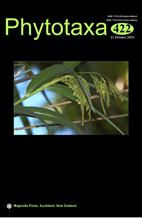Abstract
The Bromeliaceae Flora for the state of Rio Grande do Norte, Northeastern Brazil, is presented, based on extensive fieldwork, morphological analyses using herbarium and freshly collected material, and specialized literature. Twenty-six species of bromeliads were recorded in Rio Grande do Norte, distributed in ten genera and in three subfamilies. Bromelioideae was the richest subfamily (eight genera/14 species), followed by Tillandsioideae (one genus/12 species), and Pitcairnioideae (one genus/one species). Aechmea mertensii, Hohenbergia horrida and Tillandsia tenuifolia are new records for Rio Grande do Norte. Eight species (31%) are restricted to the Eastern portion of the state, in the Atlantic Forest. Caatinga dry woodlands harbor 18 species, with remarkable presence of Bromelia laciniosa, Encholirium spectabile, Tillandsia recurvata and T. streptocarpa, the four most widely distributed taxa. We discuss problems related to unclear taxonomic circumscriptions of species or diverging information between authors, more expressively in Hohenbergia, but also in Aechmea, Cryptanthus and Tillandsia. The data presented here might contribute to better understand the morphological variation of these taxa and suggest additional research on their taxonomy. Morphological descriptions, general comments, a map, photo plates and an identification key for all taxa are provided.

